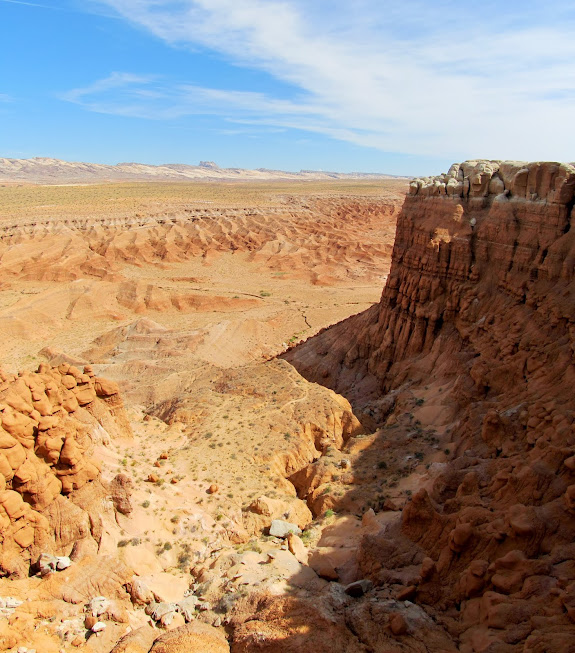Today’s adventure was a great whole-family trip. I’d planned for some hiking at Goblin Valley and canoeing at Joe’s Valley. I was awake by 6AM, which seems to be the norm with the puppy and her immature bladder. Due to a lot of preparation the night before we were on the road before 7:30 and hiking in Goblin Valley by 9:30. There were three geocaches in the area that I hadn’t already found and I’d hoped to find them all, but we only made it to two. The family took a leisurely stroll through the goblins toward the first cache. We saw many signs of recent precipitation but luckily conditions were dry enough for some comfortable hiking. The first geocache was an easy find. We moved toward the second, but this one was a toughie and hadn’t been found in the two months since it was placed.
I ditched Traci, the kids, and the dogs a mere 300 feet (as the raven flies) from the next geocache, though it took me 30 minutes to routefind my way there. It was a fun challenge climbing my way up and through many narrow gaps and steep chutes. Once I topped out on the white Curtis Formation, I was more confident that I could easily make my way to the geocache. My only concern then was that I wouldn’t find an empty logbook. My GPS zeroed out on top of a ledge and logic dictated that the cache must be below the ledge. It was indeed there and I was relieved to find an unspoiled logbook. From my perch above Goblin Valley I could look down upon (literally, not figuratively) the other park-goers. There were families and kids playing in the goblins and young adults scrambling up the ledges and cliffs on the east side of the valley. I walked along a ledge to the south until I could see Traci and I hollered down to her letting her know I’d made it safely to the top. I surprised both of us by making it back down to the bottom in about 10 minutes. We wandered our way back toward the parking lot, letting the kids play as long as they wanted in the goblins. We grabbed lunch in the Jeep as I started the drive to Joe’s Valley.
2.5 hours later we were at Joe’s Valley but I was unnerved by the signs we’d seen along the way saying that the boat ramp was closed. We could see that the water level was a little below the level of the concrete boat ramp. The gate at the top of the boat ramp was locked, but the canoe only weighs 80 pounds and Traci and I carried it over the gate and 400 feet to the water fairly easily. We made a couple of trips from the Jeep to the water’s edge carrying chairs, a shade tent, life jackets, and various other gear. As soon as Traci and the kids were set up comfortably I set out for a solo paddle. I wanted to see, up-close, the names I’d seen carved in the cliffs a few months ago, but unencumbered by young’uns and mutts. It took me 35 minutes to paddle just over a mile to the south side of the dam. A headwind slowed me down and made traveling in a straight line difficult. I was looking forward to the return trip with a tailwind, though. I beached the canoe and started scrambling up the steep hillside toward the names/initials I’d seen high on the cliffs.
I easily found some names that I hadn’t seen on the earlier trip, but the other names eluded me at first. The first set of names dated to as early as 1929, the most prominent being from the Reid family. I deduced that the other names must be on a higher cliff band that’s only visible from the water and I started looking for a way up there. One narrow route led up above the cliffs with the first set of names, and there I found the initials that I’d seen earlier from the reservoir. There were a couple sets of initials there–E.J., A.P., and B.J., one with what looked like a 1903 date. I finally felt like I’d seen all that I came to see and I paddled back to my waiting family. I was disappointed to find the wind had died down–I was under my own power the entire way back. I arrived at the boat ramp to find Traci all ready to leave–she didn’t enjoy the wind and sprinkles that fell over the area and had packed up the Jeep. We carried and secured the canoe and hit the road.
Our last plans for the day were for dinner near Grassy Lake with Traci’s cousin and his family. They’d been camping there since mid-week and we hadn’t heard from them since before they left town. I wasn’t sure where to find them except somewhere near Grassy Lake, so we drove around the area but came up empty. We later found out that they’d unexpectedly gone home earlier that day. So, for dinner, we stopped at the same spot where Chris and I camped on the first night of our 321-mile ATV ride three years earlier. We re-heated some bratwurst over a small fire and downed it with some chips or crackers, then had cookies for dessert. During the drive back down toward Joe’s Valley we were treated to a colorful sunset as some dark clouds dumped rain on the mountain where we’d just come from. Back at home I snagged a webcam photo of me canoeing across the dam from here.
Photo Gallery
GPS Tracklog and Photo Waypoints (Google Earth .KMZ Format)
GPS Tracklog and Photo Waypoints (Google Maps)


